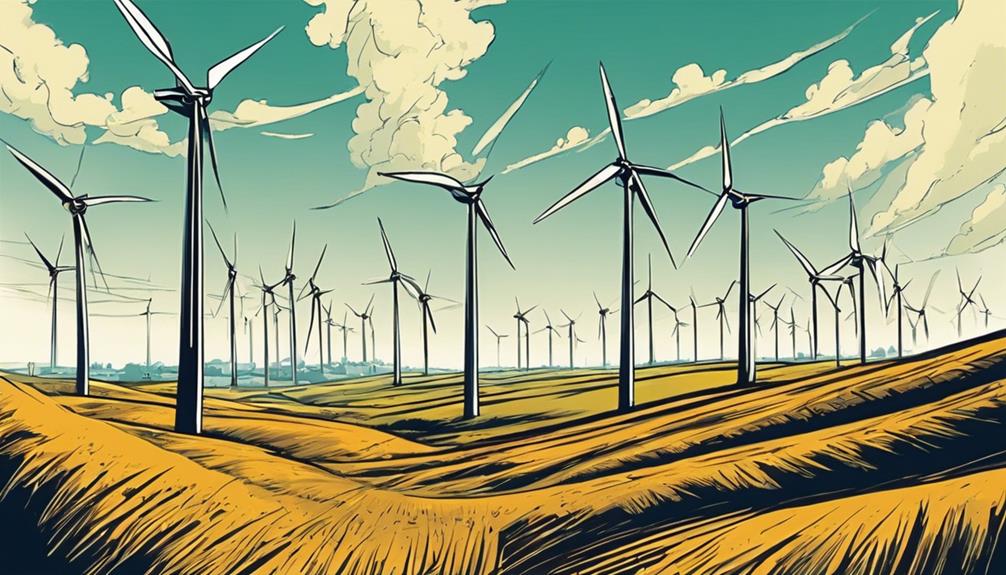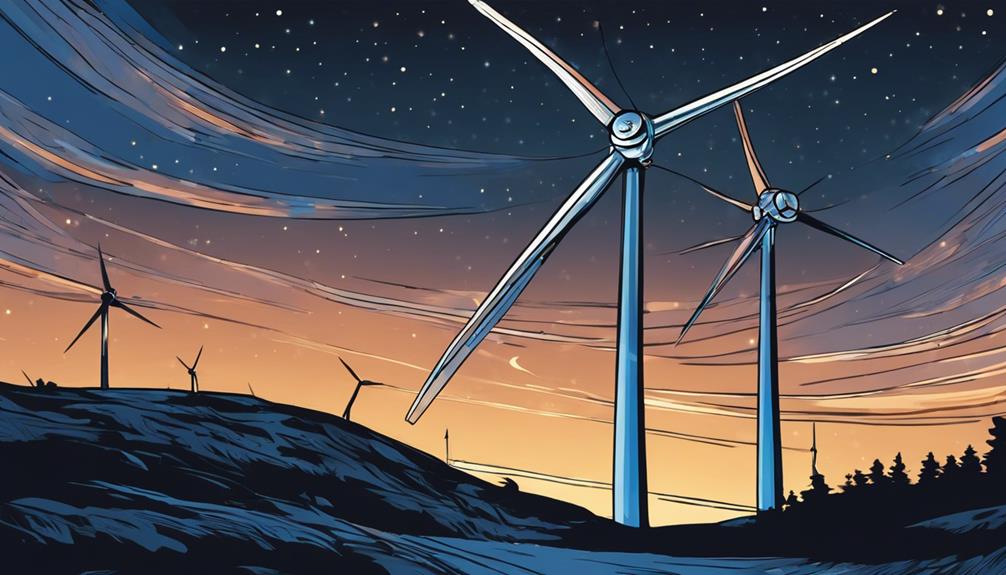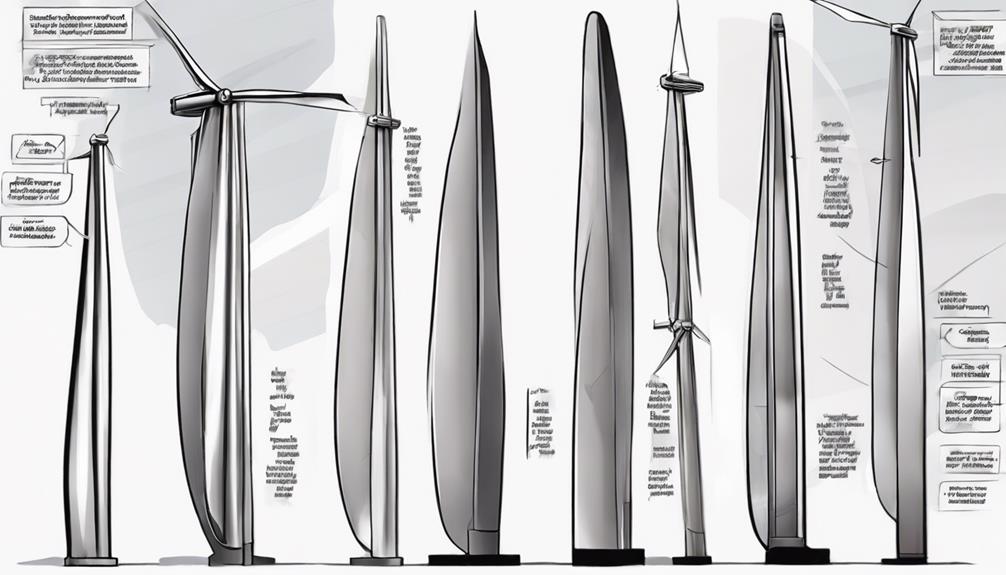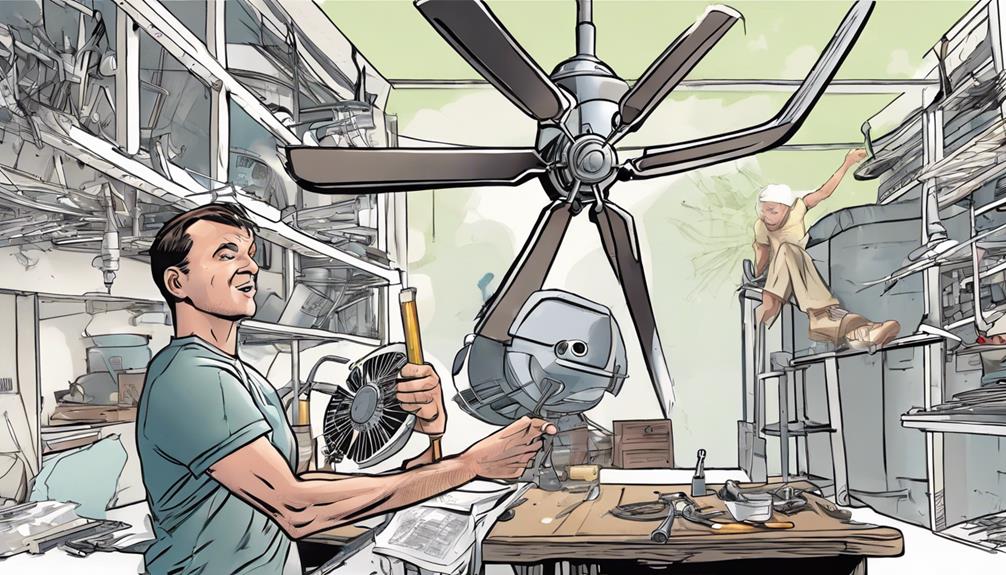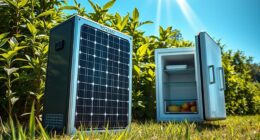Uncover the wonders of wind energy, where turbines convert wind power into eco-friendly electricity. Enjoy the benefits of clean energy with financial advantages and global accessibility. By utilizing wind energy, you reduce greenhouse gas emissions and advance renewable energy goals. Take a closer look at the impacts on wildlife and strategies for mitigation while exploring various types and technologies in wind energy projects. Discover the impressive growth in wind energy production and cost reductions. Embrace wind power’s potential for sustainable development and efficient energy utilization. Explore the vast domain of wind energy and its endless possibilities.
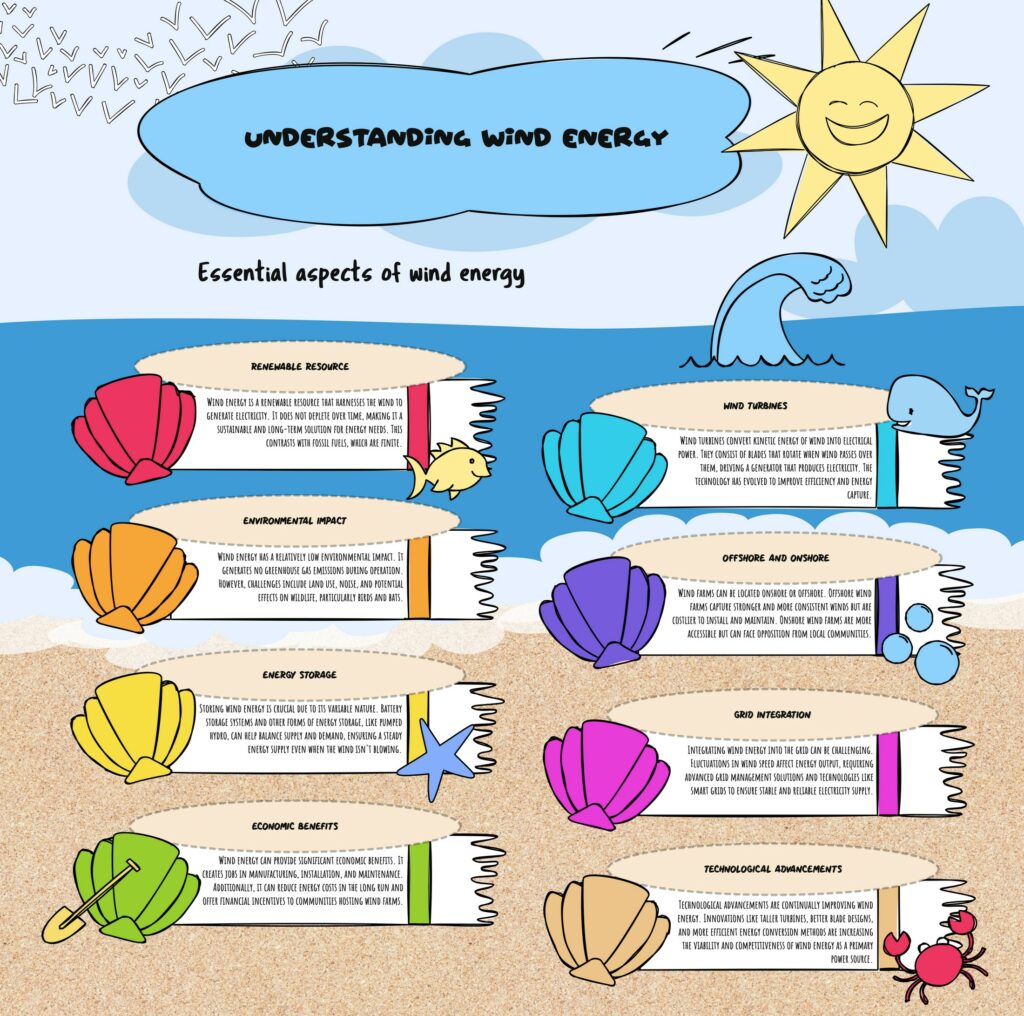
Key Takeaways
- Wind energy harnesses wind power for clean electricity.
- Wind power is renewable, eco-friendly, and cost-effective.
- Wind turbines reduce greenhouse gas emissions.
- Different types include onshore, offshore, and distributed wind projects.
- Global wind energy capacity and cost have significantly improved.
Wind Power Basics
Wind power operates by harnessing the energy from the wind to produce electricity efficiently and cleanly.
Wind power – Renewable energy source for generating electricity
| Definition | Wind energy is used to generate electricity, primarily through wind turbines grouped into wind farms. |
| Electricity Production | In 2022, wind power supplied over 2000 TWh of electricity, accounting for over 7% of world electricity. |
| Global Capacity | As of 2021, global installed wind power capacity exceeded 800 GW, with fastest growth in China and the United States. |
Benefits of Wind Energy
Wind energy offers many advantages as a renewable energy source:
- Clean and sustainable: Wind energy does not emit greenhouse gases or air pollutants. It is renewable and inexhaustible as long as the wind blows.
- Cost-effective: The cost of wind energy has decreased significantly and is now competitive with fossil fuels in many locations.
- Job creation: Developing and maintaining wind farms creates jobs in engineering, construction, and maintenance.
- Energy independence: Wind is an indigenous energy source available in most countries, reducing reliance on energy imports.
- Low environmental impact: Wind farms can be dismantled without leaving an environmental footprint, and the land can be reused.
Wind Turbines
Wind turbines play a pivotal role in this process by converting the wind’s kinetic energy into electrical energy through generators and turbine blades. These turbines are designed to capture the wind’s energy and transform it into usable electricity.
Wind power plants can either stand alone or be part of larger wind farms that contribute energy to the grid.
Wind turbines have become increasingly popular for generating electricity due to their renewable nature and minimal environmental impact.
Beyond electricity generation, windmills can also serve other purposes such as grinding grains.
The versatility of wind power makes it a promising renewable energy source with the potential for widespread adoption in various locations.
Benefits of Wind Energy
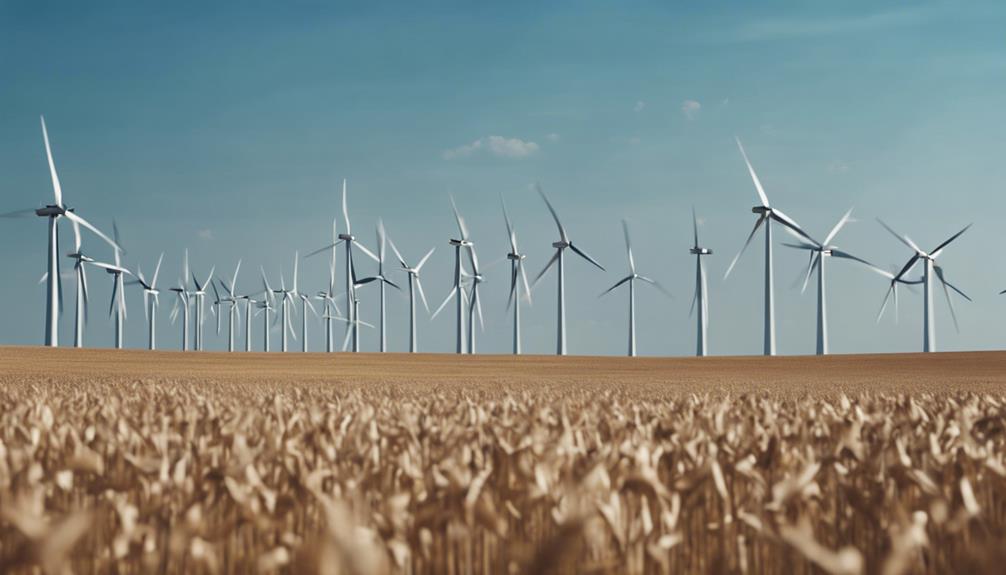
Harnessing wind energy offers numerous advantages, including its renewable and clean nature, financial benefits, and potential for widespread accessibility. Wind energy is a sustainable and environmentally friendly way of generating electricity with no greenhouse gas emissions, making it a key player in the realm of renewable energy. Financially, wind energy presents low energy costs and tax incentives, providing both individuals and businesses with economic advantages. Moreover, the power of the wind can be harnessed in various locations, even remote areas, ensuring electricity generation where traditional power sources may be limited. The electrical grid stands to benefit greatly from wind energy’s potential, contributing to long-term energy sustainability and reducing dependency on non-renewable resources.
| Advantages of Wind Energy | ||
|---|---|---|
| Renewable and Clean Nature | Financial Benefits | Widespread Accessibility |
| Sustainable Energy Source | Low Energy Costs | Potential for Remote Areas |
| Reduced Greenhouse Gas Emissions | Tax Incentives | Increased Energy Independence |
| Contribution to Renewable Energy Goals | Economic Advantages | Grid Integration |
| Research and Development Investment | Energy Sustainability | Reduced Reliance on Fossil Fuels |
Impacts and Mitigation of Wind Energy
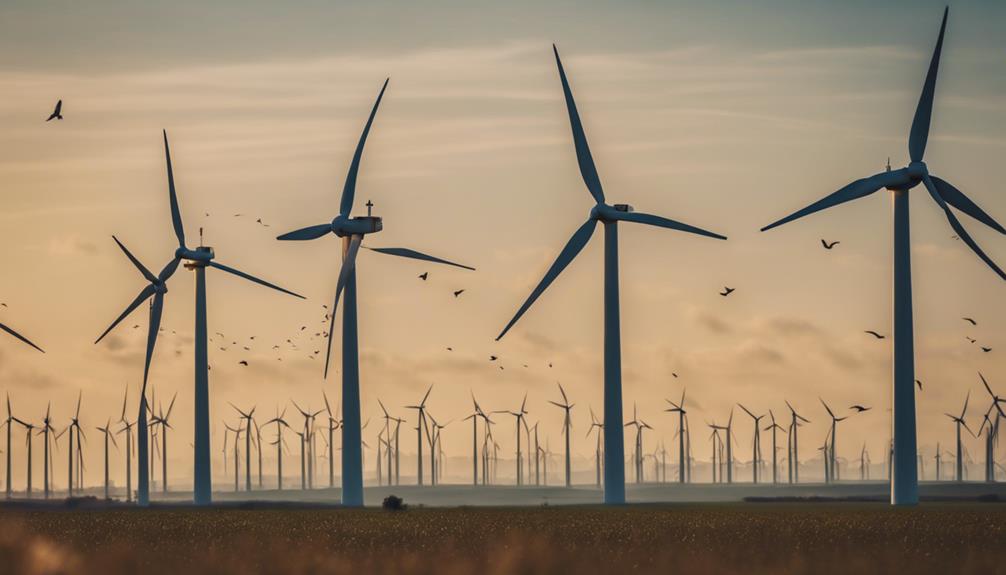
You’ll explore how wind energy projects aim to protect wildlife through innovative strategies and engage local communities effectively.
Initiatives focusing on wildlife protection and community engagement are essential for sustainable wind energy implementation.
Wildlife Protection Strategies
Implementing effective wildlife protection strategies is crucial in minimizing the impacts of wind energy on bird and bat populations. To address bird and bat collisions with turbines, wind farms utilize radar systems to detect approaching wildlife and adjust turbine operations accordingly. Additionally, acoustic deterrents emit sounds that discourage birds and bats from flying too close to the turbines, reducing the risk of collisions.
Studies suggest that compared to other human activities like buildings and roads, wind turbines have a relatively lower impact on wildlife. Repowering older wind farms with newer, more efficient turbines can further help mitigate these impacts by reducing the number of turbines needed while increasing energy output.
Furthermore, decommissioning guidelines guarantee that when wind turbines reach the end of their lifespan, they’re properly removed to minimize disruption to wildlife habitats.
Community Engagement Initiatives
Engaging with local communities is vital in addressing concerns and mitigating the impacts of wind energy projects on various aspects, including wildlife and the environment. Community engagement initiatives play an essential role in guaranteeing that wind energy projects meet energy needs while minimizing adverse effects.
Large turbines, often a concern for communities, can be managed effectively through community involvement. By taking advantage of community feedback and involvement, developers can address issues related to greenhouse gas emissions and other environmental impacts.
Efforts to involve local communities in wind energy projects help build trust and transparency. Strategies such as repowering and decommissioning are employed to reduce the impact on wildlife and the environment. The secure nature of wind turbines against cyberattacks also assures communities of safety and security.
Collaborative endeavors between developers and communities are ongoing to address concerns comprehensively and ensure the sustainable development of wind energy projects in various locations.
Types and Applications of Wind Energy
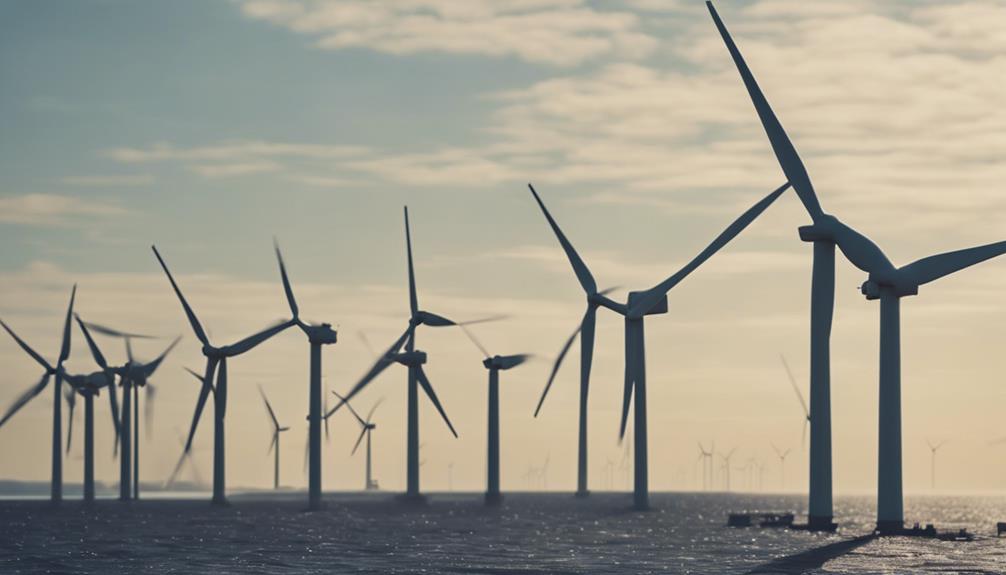
The types and applications of wind energy vary widely, catering to diverse energy needs across different sectors. Offshore wind turbines, a prominent form of wind energy, harness the power of wind to generate electricity on a large scale. These turbines are strategically placed in bodies of water to take advantage of strong, consistent winds. Additionally, wind energy plays an essential role in energy storage solutions, allowing excess energy generated during peak wind conditions to be stored for use when the wind isn’t blowing.
Furthermore, wind energy is utilized in various applications such as distributed wind energy, which caters to on-site energy demands for homes, schools, businesses, and farms. Utility-scale turbines are another common application, generating substantial amounts of electricity for the grid. Hybrid power plants that combine wind, solar, and energy storage technologies are also becoming increasingly popular, offering enhanced efficiency and reliability in energy production.
Wind energy projects involve intricate processes, including obtaining utility approvals, conducting grid impact studies, and coordinating with stakeholders to guarantee successful implementation. Wind energy applications also support microgrids, reduce electricity consumption, and provide power for off-grid structures.
Wind Energy Technology and Projects
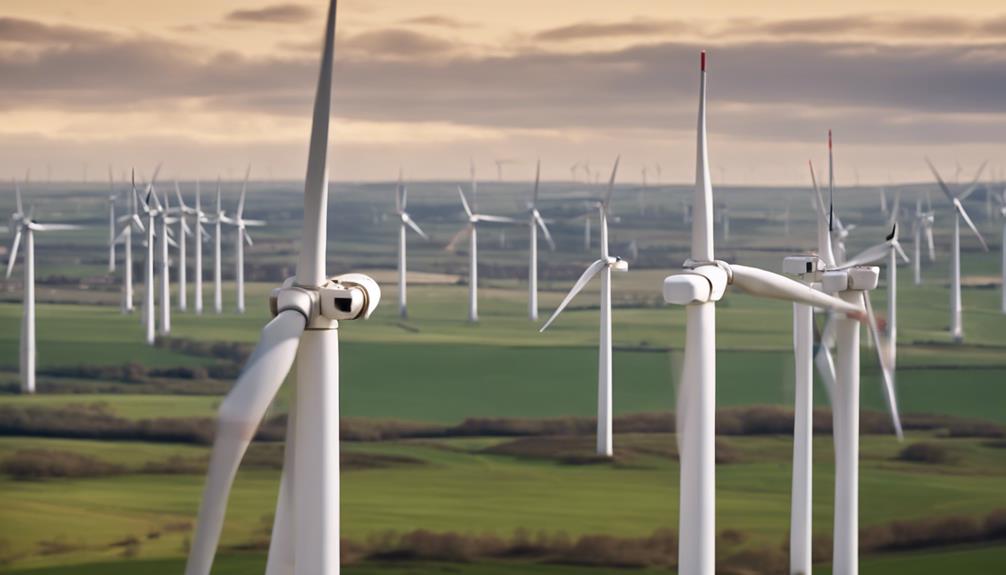
Let’s talk about the efficient wind turbines used in land-based projects and the strategic development processes involved.
These turbines play an essential role in generating cost-competitive electricity.
Understanding the strategies behind project development can shed light on the advancements in wind energy technology.
Efficient Wind Turbines
To maximize renewable energy output and efficiency, understanding the technology behind efficient wind turbines is essential in wind energy projects.
Turbines are the heart of wind energy generation, harnessing the power of the wind to generate electricity.
Rotor blades are a key component of turbines, capturing the energy as the wind blows and converting it into rotational motion.
Efficient turbines play an important role in land-based wind energy projects, ensuring cost-competitive electricity generation.
Offshore wind turbines are designed to capture the powerful winds over the ocean, adhering to specific regulations to minimize marine impacts.
Distributed wind projects offer on-site electricity generation for various purposes, often integrating with solar panels and storage systems.
Wind power applications extend to supporting microgrids, reducing electricity consumption, and providing power for off-grid structures.
As stakeholders continue to develop advanced technologies, safety standards, and environmental considerations, the efficiency of wind turbines remains a crucial focus in the field of wind energy.
Project Development Strategies
For ideal wind energy project development, consider strategic placement of turbines in windy areas to maximize energy production. Land-based wind projects utilize highly efficient turbines to generate cost-competitive electricity. Offshore wind projects capture powerful ocean winds and adhere to specific regulations for marine impacts. Distributed wind projects offer on-site electricity for various purposes and can be combined with solar panels and storage solutions. Wind power applications can support microgrids, decrease electricity consumption, and supply power to off-grid structures.
| Strategies | Description |
|---|---|
| Land-based wind projects | Utilize efficient turbines for cost-competitive electricity generation. |
| Offshore wind projects | Capture powerful ocean winds with attention to marine impact regulations. |
| Distributed wind projects | Provide on-site electricity and integrate with solar panels and storage. |
| Wind power applications | Support microgrids, reduce electricity use, and power off-grid structures. |
Wind Energy Production Growth
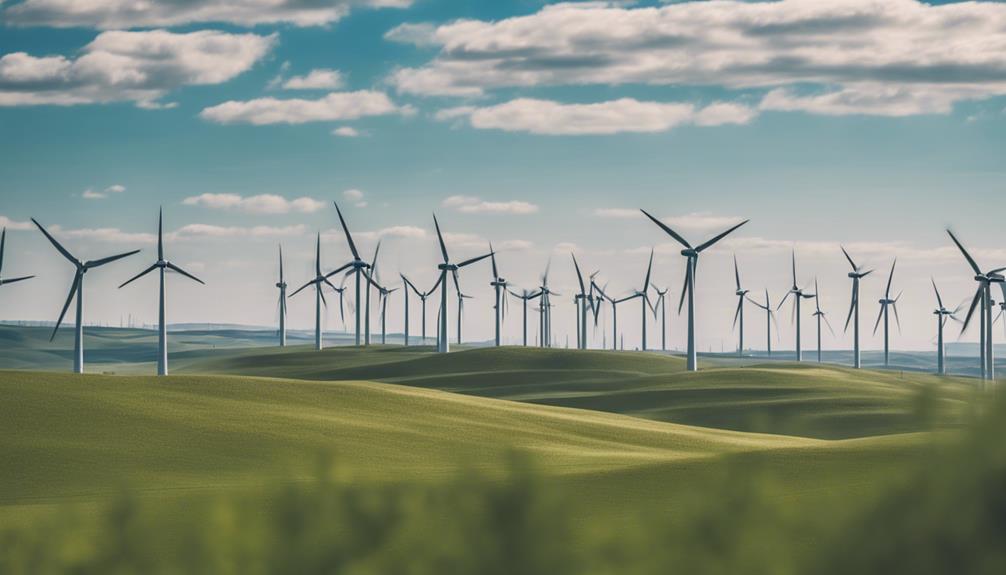
The growth in wind energy production has been remarkable in recent years, with global capacity increasing substantially. From 1997 to 2018, global wind generation capacity surged by a factor of 98, showcasing the significant expansion in the wind energy sector.
Onshore wind capacity skyrocketed from 178 GW in 2010 to 699 GW in 2020, indicating a notable rise in land-based wind power projects and wind farms. In the offshore sector, capacity saw a substantial growth spurt, climbing from 3.1 GW in 2010 to 34.4 GW in 2020, highlighting the increasing focus on offshore wind energy installations.
The production of wind power also surged by a factor of 5.2 between 2009 and 2019, emphasizing the rapid escalation in generating electricity from wind sources. Wind energy’s contribution to renewable electricity production reached 6% in 2016, underlining its role in reducing greenhouse gas emissions and promoting sustainable energy practices.
Cost Reduction and Technology Advancements
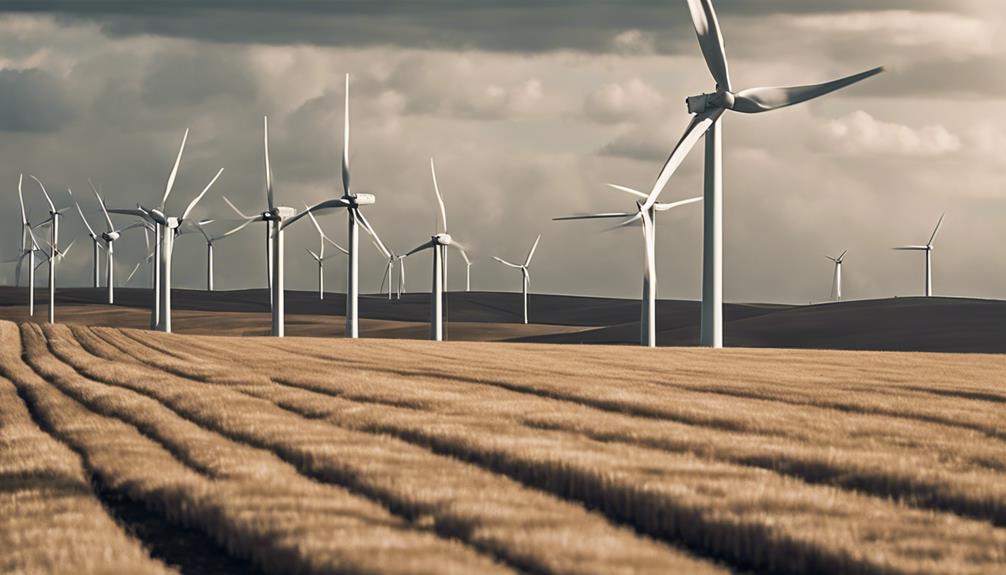
Amidst notable progress in technology and noteworthy cost reductions, wind energy has undergone a transformative evolution in recent years.
The global weighted-average LCOE of onshore wind has decreased by 56% from 2010 to 2020, making it a more cost-effective option for generating electrical power.
Similarly, newly commissioned offshore wind projects have seen a 48% reduction in LCOE during the same period, improving their economic viability for wind farms.
With the increase in wind turbine capacity to 3-4 MW for onshore turbines and 8-12 MW for offshore turbines, the capabilities to generate power have been greatly enhanced.
The output of wind power is directly linked to rotor dimensions and wind speed cubed, underlining the importance of efficient turbine design for maximizing electrical production.
It’s essential to note that wind power potential grows exponentially as wind speed doubles, emphasizing the necessity of ideal wind conditions for maximizing energy generation efficiency.
Frequently Asked Questions
What Is the Full Explanation of Wind Energy?
Wind energy harnesses the power of the wind to generate electricity through wind turbines. Turbines convert wind’s kinetic energy into rotational energy, driving generators to produce electricity. Factors like turbine size and wind speed affect power output.
What Are 5 Interesting Facts About Wind Energy?
Imagine a dance of power in the air. Wind energy, a force of nature harnessed by humanity. It boomed, growing 98 times from 1997 to 2018. Onshore and offshore capacities surged, while wind power quintupled from 2009 to 2019.
What Is the Main Idea of Wind Energy?
Wind energy’s main idea is harnessing wind to generate clean electricity efficiently. Wind turbines convert wind’s kinetic energy into electrical power. This renewable source contributes substantially to global electricity production, offering sustainability and minimal environmental impact.
What Is the Key Information About Wind Energy?
In the domain of sustainable power, wind energy reigns supreme. Harnessing the force of the winds, it has surged in growth – 98 times since 1997. Onshore and offshore capacities have swelled, propelling wind into the renewable spotlight.
How Does Wind Energy Contribute to Energy Conservation in Everyday Life?
Wind energy plays a crucial role in the importance of energy conservation. By harnessing the power of the wind, we can generate clean and renewable electricity to power our homes, businesses, and communities. This helps reduce our reliance on non-renewable energy sources and contributes to a more sustainable and eco-friendly future.
How Does Wind Energy Contribute to Energy Conservation in Everyday Life?
Wind energy plays a crucial role in the importance of energy conservation by providing a clean and sustainable source of power. Wind turbines convert the kinetic energy of wind into electricity, reducing the reliance on fossil fuels and minimizing environmental impact. This contributes to a more sustainable and energy-efficient everyday life.
Conclusion
So there you have it, everything you need to know about wind energy. Now you can sit back, relax, and enjoy the breeze knowing that you're helping save the planet one gust at a time.
Who knew harnessing the power of the wind could be so easy and beneficial? Keep on blowing, wind turbines, keep on blowing.
